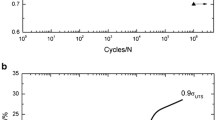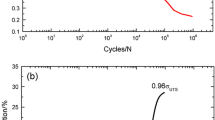Abstract
While continuous fiber, unidirectional composites are primarily evaluated for their longitudinal properties, the behavior transverse to the fibers often limits their application. In this study, the tensile and creep behaviors of SCS-6/Ti-6Al-4V composites in the transverse direction at 482 °C were evaluated. Creep tests were performed in air and argon environments over the stress range of 103 to 276 MPa. The composite was less creep resistant than the matrix when tested at stress values larger than 150 MPa. Below 150 MPa, the composite was more creep resistant than the unreinforced matrix. Failure of the composite occurred by the ductile propagation of cracks emanating from separated fiber interfaces. The environment in which the test was performed affected the creep behavior. At 103 MPa, the creep rate in argon was 4 times slower than the creep rate in air. The SCS-6 silicon-carbide fiber’s graphite coating oxidized in the air environment and encouraged the separation of the fiber-matrix interface. However, at higher stress levels, the difference in behavior between air- and argon-tested specimens was small. At these stresses, separation of the interface occurred during the initial loading of the composite and the subsequent degradation of the interface did not affect the creep behavior. Finally, the enrichment of the composite’s surface by molybdenum during fabrication resulted in an alloyed surface layer that failed in a brittle fashion during specimen elongation. Although this embrittled layer did not appear to degrade the properties of the composite, the existence of a similar layer on a composite with a more brittle matrix might be very detrimental.
Similar content being viewed by others
References
P. Wright, R. Nimmer, G. Smith, M. Sensmeier, and M. Brun: inInterfaces in Metal-Ceramics Composites, R.Y. Lin, R.J. Arsenault, G.P. Martins, and S.G. Fishman, eds., TMS, Warrendale, PA, 1989, pp. 389–409.
S.M. El-Soudani, and M.L. Gambone: inFundamental Relationships between Microstructures and Mechanical Properties of Metal Matrix Composites, P.K. Liaw and M.N. Gungor, eds., TMS, Warrendale, PA, 1990, pp. 669–704.
W.S. Johnson, S.J. Lubowinski, and A.L. Highsmith: inThermal and Mechanical Behavior of Metal Matrix and Ceramic Matrix Composites, J.M. Kennedy, H.H. Moeller, and W.S. Johnson, eds., ASTM STP 1080, ASTM, Philadelphia, PA, 1990, pp. 193–218.
R.P. Nimmer, P.A. Siemers, and M.R. Eggleston:Compos. Eng., 1994, vol. 4, pp. 1289–1305.
C.J. Lissenden, C.T. Herakovich, and M.-J. Pindera:Inelastic Deformation of Metal Matrix Composites, Report No. Am-93-03, University of Virginia, Charlottesville, VA, 1993.
EX. Hall and A.M. Ritter:J. Mater. Res., 1993, vol. 8, pp. 1158–68.
M.L. Gambone:Fatigue and Fracture of Titanium Aluminides, WRDC-TR-89-4145, Wright-Patterson AFB, OH, 1989.
P.K. Wright: inTitanium Matrix Components, P.R. Smith and W.C.Revelos, eds., Wright-Patterson AFB, OH, 1992, pp. 251–76.
M.R. Eggleston: inProc. 7th Int. Cong, on Experimental Mechanics, The Society of Experimental Mechanics, Bethel, CN, 1992, pp. 368- 75.
RMI 6AI-4V, Reactive Metals, Inc., Niles, OH, 1967.
M.R. Eggleston and E. Krempl:Mech. Compos. Mater. Struct., 1994, vol. 1, pp. 53–73.
R.S. Mishra and D. Banerjee:Mater. Sci. Eng., 1990, vol. A130, pp. 151–64.
George F. Lucas and Terry R. McNelley:Metall. Trans. A, 1976, vol. 7, pp. 1317–24.
E.M. Breinan and K.G. Kreider:Metall. Trans. A, 1973, vol. 4, pp. 1155–65.
R.N. Shenoy, J. Unnam, and R.K. Clark:Oxid. Met., 1986, vol. 26, pp. 105–24.
D.R. Pank, A.M. Ritter, R.A. Amato, and J.J. Jackson:Titanium Aluminide Composites, WL-TR-91-4020, P.R. Smith, S.J. Balsone, and T. Nicholas, eds., Wright-Patterson AFB, OH, 1991, pp. 382–98.
M. Khobaib: inTitanium Aluminide Composites, WL-TR-91-4020, P.R. Smith, S.J. Balsone, and T. Nicholas, eds., Wright-Patterson AFB, OH, 1991, pp. 450–66.
M. Khobaib: inProc. American Society for Composites: 6th Tech. Conf, Technomic Publishing Company, Lancaster, 1991, pp. 638–47.
Author information
Authors and Affiliations
Rights and permissions
About this article
Cite this article
Eggleston, M.R., Ritter, A.M. The transverse creep deformation and failure characteristics of SCS-6/Ti-6AI-4V metal matrix composites at 482 °C. Metall Mater Trans A 26, 2733–2744 (1995). https://doi.org/10.1007/BF02669429
Received:
Published:
Issue Date:
DOI: https://doi.org/10.1007/BF02669429




